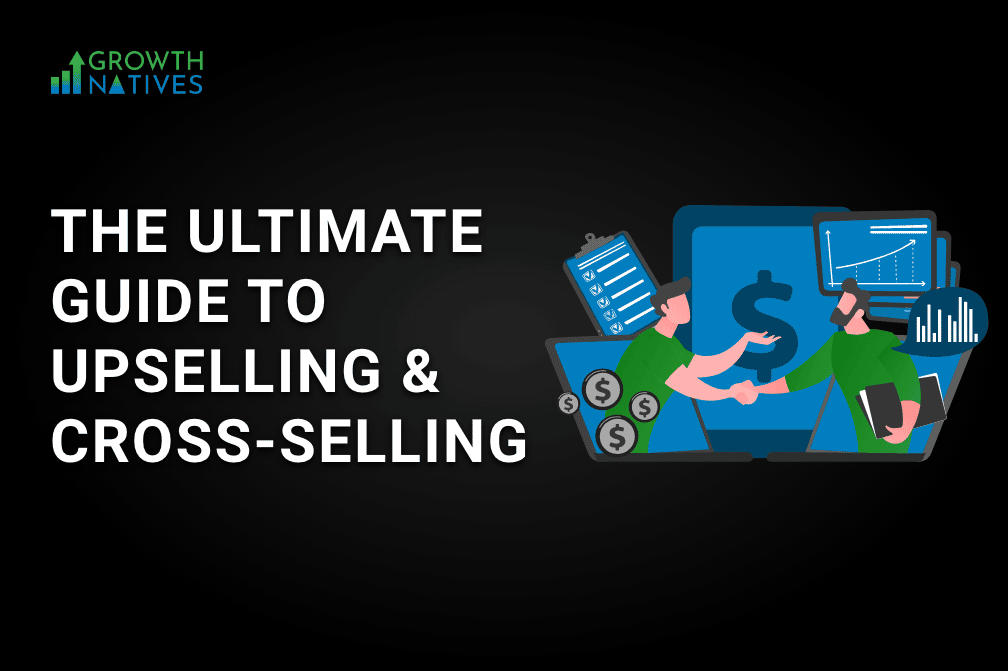The Ultimate Guide to Upselling and Cross-Selling

Table of Contents
Upselling and cross-selling make perfect sense at a time when businesses are staring at a possibility of an economic slowdown. These two sales techniques hold the potential to retain your existing customers and make them your brand advocates which eventually helps your business grow to newer heights—only if you know how to approach it well.
Let us look at some statistics:
- According to Marketo, 90% of customer value for B2B businesses is realized after the first sale.
- Today, companies such as Amazon make 35% of their revenue through upsells and cross-sells.
- Product recommendations account for an average of 10-30% of revenue on eCommerce sites.
Upselling and cross-selling can help you hit and possibly exceed your revenue goals.
So, what exactly are these two? How are they different? And how can you use them in your marketing strategy?
Read on to know.
Upsell Vs. Cross-Sell
Both upsell and cross-sell add new facets to the everyday phenomenon of selling. It is a fact that a customer's revenue possibilities continue even after the first point of sale. Also, these concepts are not altogether new as it has always been part of brick-and-mortar stores. What has changed is that the techniques have evolved with their adoption in the digital world.
Upselling: Accessorize Your Purchase
Every time a server asks whether you want cheese in your burger is a classic case of upselling. Upselling promotes purchases where customers pay extra for an upgrade, enhancement, or premium option of their desired product. The popularity of "Add an accessory" and other upsell tabs on Amazon point to its evolution in the e-commerce world.
For example, Tesla, through its user-friendly website, allows its online visitors to configure their cars before purchase. It also gives them a good opportunity for some upselling. Similarly, the airline industry has really harnessed the art of upselling for upgrades. Whether it be your meal preference, seat, luggage, or any other customized request, airlines now know that customers do not mind a small added price in exchange for more value for their purchase.
Upselling is also a good practice to sell more and increase revenue from your existing pool of customers. Data indicates that 60-70% of sales are made to existing customers than new customers, whose purchase ranges from 5 to 20%.
Reason: They already enjoy the quality of your products and are open to more upgrades for a premium.
Cross-Selling: Fulfil All Your Needs
Cross-selling is a technique that points customers to products they would eventually purchase along with the product that they seek. An everyday example of cross-selling is buying fries when all you needed was just a burger.
By suggesting ancillary products or services, you solve your customers' problems while anticipating their needs and increasing their investment. To ensure additional products are bought, you need to cross-sell at the right time.
Apple makes a simple, passive cross-sell with its recommendations. For instance, a customer on Apple's website finds accessories and add-ons mapped to the product of their choice. Similarly, Amazon's "You might also be interested in…" and "Most customers buy these products" tabs below the main product are its way of making cross-sell recommendations to their online shoppers.
Bundling: A Curated Upsell/Cross-Sell
A variation of upselling and cross-selling is bundling, where you provide a curated choice of products for your customers. This is often used by customers relying on you to simplify complex shopping decisions.
By pairing the main product with other essentials needed and providing a discount on this bundle, you raise the perceived value of your product.
6 Steps for a Successful Upsell and Cross-Sell
Below are the steps to follow when you upsell and cross-sell:
Establish Your Goals
Outlining your goals ensures that you are developing the right upsell and cross-sell strategy to achieve them. By mapping your goals for different stages of the revenue funnel, you can measure your impact along the way.
In case of none, you can use historical campaign data or build a baseline by focusing on conversion rates between revenue stages and potential sales scenarios and conversion. If you have a marketing automation platform, you can map your goals based on the customer revenue model, sales volume and speed, and the flow of customer leads.
Know Your Audience
For a successful cross-sell and upsell, go beyond buyer personas and gather more information about your audience once they buy your product. Collect customers' demographic and psychographic data and feedback to create Ideal Customer Profiles, identify their goals, and overcome obstacles in identifying the most relevant, pertinent products for an upsell and cross-sell.
Etch Out Customer Journeys
Customer journeys are essential to identify how your customers will use your products and anticipate their needs. Below are the different stages of consideration.
Enablement: Here, you work to meet your customer's expectations from your product and deliver a great customer experience. It includes post-sale onboarding and enablement services. Give your customers enough time to know your product before sending them other opportunities.
Adoption/Retention: This stage is essential to identify both cross-sell and upsell opportunities because your objective in this stage is to increase adoption and customer retention. When your product adoption increases, your customers realize your product value, and you establish the much-needed trust.
Growth: This stage is where you make the cross-sell/upsell pitch and compel your customers to increase their investment in your business. It allows you to optimize your cross-sell strategies while growing simultaneously.
Advocacy: The chatter around your product will increase once your customers see the
results and trust your brand. They will tell others about it and increase referrals. According to the Edelman Trust Barometer, 84% of B2B businesses start the buying process with a referral.
Segment Your Customer Base
Segmenting the customer base is critical at this stage of expanding your cross-sell and upsell strategy. Identify the most significant, most profitable segments and simultaneously delve further into the smallest and least profitable customers who demand a lot of effort and resources.
Once done, create a strategy for cross-selling and upselling that will work for each of these segments and existing ones, such as demographics, firmographics, geographic and behavioral, product ownership, usage, and product interest.
Provide Solutions Mapped to Products
After defining your marketing segments:
- Map them to your existing products and services.
- Look for products or solutions your customers already have and identify products that can further solve their needs.
In other words, identify opportunities where this gap exists.
Based on this approach, you can provide new perspectives to your sales team, so they know how to approach each account uniquely. This will help integrate cross-sell and upsell campaigns into your marketing approach.
Develop Your Program
The final step is where you decide your marketing tactics. The optimal approach would be to use various programs to engage customers across different channels. Reach out to your existing customers while saving on pricey acquisition programs. If unsure what would work, you can always test it out through email, webinars, and live events and go from there. This would help optimize and scale your marketing campaigns.
Tips and Best Practices
Cross-selling and upselling are not your usual sales pitch. It is not one-size-fits-all, as every customer has a different need. These tips below, however, can help you standardize to some extent, your cross-sell/upsell strategy:
Maintain a Price Range
For any proposed upsell and cross-sell, ensure a price range with purchase potential. Ideally, it should not exceed 50% of your customer's original buy. Anything higher and the likelihood of conversion reduces significantly.
Make It Easy
The first mantra for a good sale is convenience. Always make it easy for customers to upgrade or include add-ons while shopping. Top it with relevant choices, and your customers will follow through.
Offer Bundles
Bundles are effective for cross-selling and upselling when created strategically. Ecommerce websites provide specific plugins that make bundling easy. For instance, Shopify's Bold Bundles make it easy to customize for each customer.
Make Recommendations
The rolling ticker of products, beneath the main product that your customer browses, is a peek into your online store. It is also a savvy way of making recommendations while showing what other customers bought, similar to your customer's object of interest.
Provide a Choice
Combining upselling and cross-selling works best as it provides multiple offers to your clients. For example, you could upsell one thing on the product page and then cross-sell another on the cart page. Sometimes, you can use the "rule of three" that, according to research, prompts better customer response.
Offer Incentives
Apart from making upselling/cross-selling easy and accessible, it would help if you also incentivized these additional purchases. It can be something as simple as free shipping. You can add freebies to their existing subscription services if you sell a service.
Leverage Social Proof
The market is another place where your customers constantly seek validation. Social proof or online reviews provide exactly that and eases purchase decisions. Successful businesses like Amazon leverage it on every page, which makes it easier to cross-sell/upsell to their customers.
Deploy Decoy Effect
Your customers expect transparency about the product when you upsell. This must include the product features, pricing breakdown, and other available options. It may not always play in your favor; that is why a lot of businesses deploy what is called a decoy effect. This strategy makes your customer switch from one product to another pricier option by introducing a third, less attractive option that alters their perception of the original two choices.
Conclusion
Getting cross-selling and upselling right takes a lot of tact, perfect timing, acute awareness, and empathy for your customers. A lot of things need to be done right to ensure that it works. You need to know how your customer feels, the kind of features or products they would find helpful, and when and where they will be most open to an additional offer. Only then will you be able to cross-sell and upsell to them.
Growth Natives are here to help you develop your successful cross-sell and upsell strategy. Write to us at info@growthnatives.com to shoot your queries or know more.
Author Box
Sakshi Arora
Sakshi Arora is a seasoned content writer and editor with extensive experience across various industries including B2C, B2B, travel, e-commerce, and IT. In her free time, she enjoys expressing her creative side through painting and writing poetry. She also finds solace in nature and has a deep spiritual connection. Music brings her immense joy.




